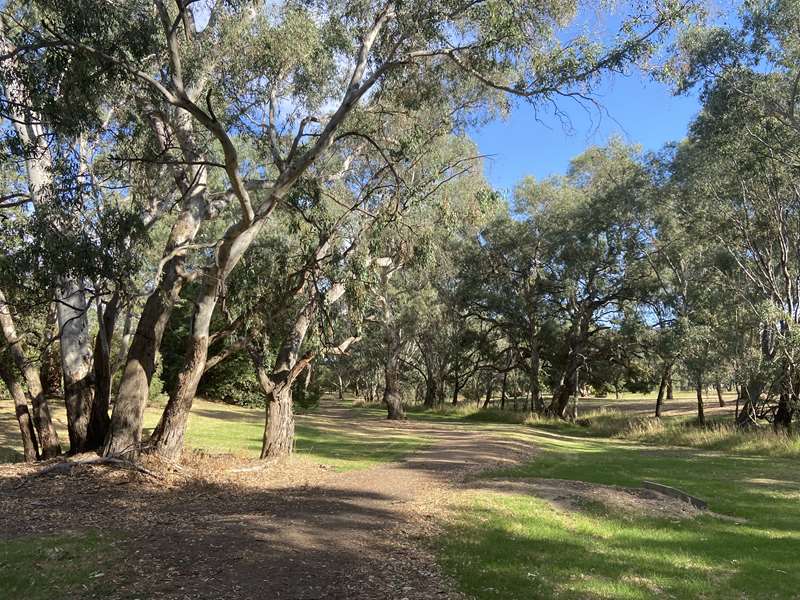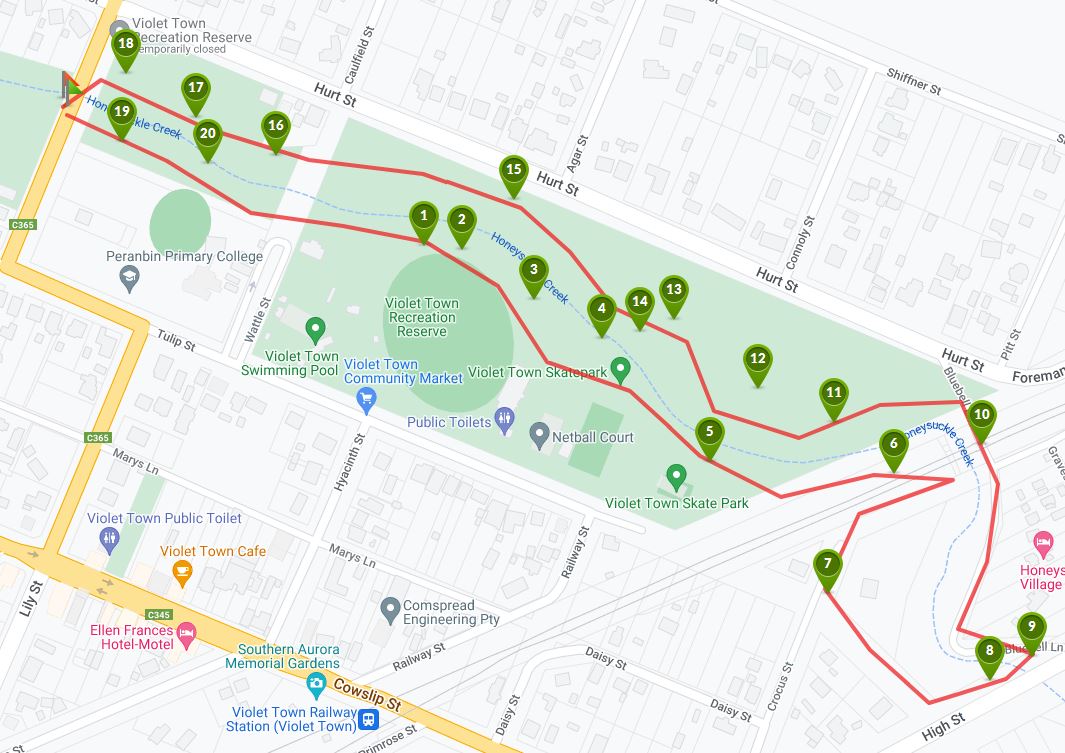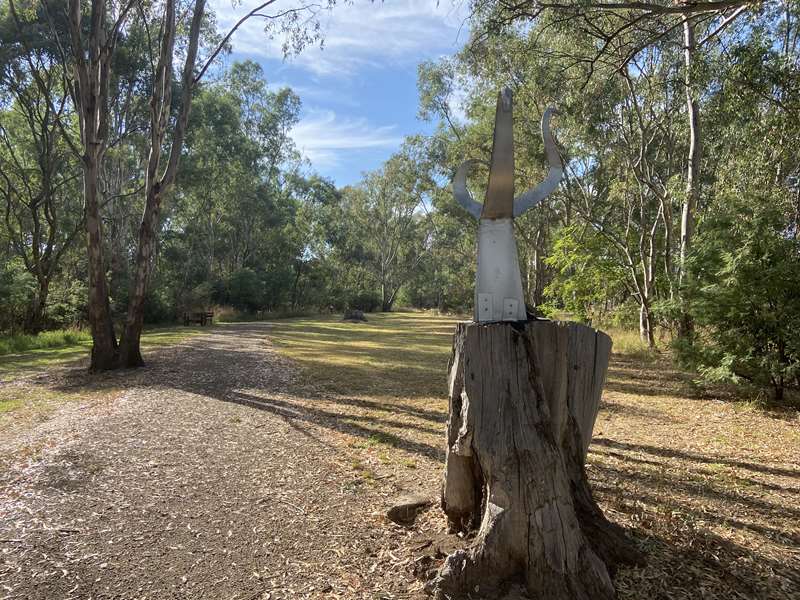Violet Town - Honeysuckle Creek Walking Track


The lovely 2.7km loop Honeysuckle Creek Track winds through parklands in the middle of Violet Town. Bridge crossings allow shorter options. Collect a "Birds of the Honeysuckle Creek" guide in town. The track begins behind the football oval. From the Post Office, walk up Hyacinth Street to the Memorial gates oval entry.
If you are only going to do one side of the creek, the southern side has more impressive trees and some shade.
Map of Route

Interactive Map
Points of Interest
1. Historical Information Board
Near the Recreation Reserve playground is an information board on the history of Violet Town.
Aboriginal people lived here for about 40,000 years before the arrival of Europeans. The first Europeans to cross the Honeysuckle Creek were the explorers Hume and HoveII in 1814. The surveyor and explorer Major Thomas Mitchell crossed at the same spot in 1836. His was the first recorded European reference to the site that Is now Violet Town.
Mitchell had set out from Sydney to chart the course of the Darling River and discovered it met the Murray River at present day Mildura. He went on to explore the Western District, and it was on his return to Sydney that he passed through what was to become Violet Town. On October 11, 1836, Mitchell's party crossed the creek and camped next to its banks. It is recorded they referred to it as both "Violet Ponds" and "Violet Creek" because of plants they found growing along its banks. It seems most likely the plant the Mitchell expedition referred to was the Showy Violet (Viola betonicifolia).
Mitchell's crossing point became the site at which the future Sydney Road (later the Hume Highway) crossed the creek. A plaque near the caravan park marks this site.
On his return to Sydney Mitchell recommended that a site next to the creek be surveyed for a town. By 1838, the plan for the area just west of the creek was drafted. Thus, Violet Town became the Port Phillip colony's first surveyed inland town.
2. Pedestrian bridge across creek
This bridge is raised high so that floodwaters pass underneath and provides a good view of the creek. You can join the walking track on the other side.
3. Creating habitat for small fauna
The collapse of a tree led to the development of a grove to provide places to hide.
4. Interpretive boards and seating
Wander off the track to find interpretive boards and seating where you can enjoy the tranquility of the area
5. Tree identification Signs
Many mature trees have identification plates to help educate visitors.
6. Railway line underpass
Follow the path underneath the old railway bridge.
7. New grove planting
To create a loop, a grove of natives was planted alongside one of Violet Town's old private hospitals called 'The Pines', built in the early 1900s.
8. High Street bridge
High Street was once the Hume Highway, since replaced by the Hume Freeway. Cross the bridge to rejoin the track on the other side of the creek.
9. Major Mitchell plaque
Major Mitchell was the first to record Violet Ponds, as Honeysuckle Creek was first known, when he visited the area in 1836. Follow the road alongside the creek to rejoin the walking track.
10. North East Railway line
The Railway came to Violet Town in 1873 and one bridge still shows the original brickwork. This area regularly floods in winter.
11. Places to hide, eat and breed
The revegetation projects along the Creek have created and recreated habitat for many types of native birds and fauna. Special plantings have occurred for the grey crown babbler and squirrel gliders.
The animals in the water need somewhere to live, somewhere to hide from predators, places to rest and places to breed. Different animals use different types of habitat, such as snags (fallen logs and branches), boulders, undercut banks and tree roots.
Blackfish like to live in and around snags and often lay their eggs inside hollow logs. The male Blackfish will wait around inside the log, fanning away any silt that threatens to smother the fertilised eggs.
The larger Trout Cod (a close relative of the Murray Cod) attaches its sticky eggs to a clean, hard surface such as a log or boulder. Macquarie Perch may migrate long distances to find suitable habitat to lay eggs.
Bugs, shrimps and insect nymphs hide under boulders and tree roots. They provide food for fish, frogs, platypus and water birds.
Because fish breathe through gills, there needs to be plenty of oxygen in the water. When water bubbles over shallow or rough areas of the creek bed, the water is aerated and oxygenated. These areas are called riffles.
Vegetation that grows In the creek in shallower and slower flowing areas provides a nursery for young fish. The stems of these plants are usually covered in algae. Bugs and insects feed on these algae providing a ready source of food for young fish. Overhanging vegetation provides shade during hotter months. Deeper holes in the creek provide cooler water. High temperatures can kill fish, particularly juveniles.
12. Grove of sheoaks and bulloaks
Just north of the track is a large grove of 200 sheoaks and bulloaks, created to provide a restful and contemplative place for people to sit or wander through.
13. Silver banksias
Honeysuckle Creek was first named after the prolifically growing banksia marginata. Many of this species have been replanted to replace those removed through agricultural development.
14. Low bridge
A second pedestrian bridge that will take you back to the football club and oval.
15. Tree hollows
Where once the creek would be cleared of dead wood, hollows in old trees such as large red gums provide safe habitat and homes.
The large old River Red Gum before you on the edge of Honeysuckle Creek is an extremely important part of the lifeblood of the creek environment. Its sheer size and age has resulted in a range of features that are now in short supply along the creek. Principal amongst these features are the hollows this tree contains.
Hollows within the trunk and branches of trees form when insects , other invertebrates, fungi, or fire (or combination of these) eat away the interior wood, leaving only an open end within the tree's 'shell'. The holes and hollowed 'spouts' you can see in this tree (as well as the ones you can't see!) are essential as denning, roosting, and importantly, nesting sites for a large number of Australian animals.
Animals such as Sugar Gliders, Squirrel Gliders, bats, and owls would be unlikely to breed in this area unless there were hollow-bearing trees such as this one.
It has taken a long time - probably 200 to 300 years - coupled with the right conditions, to create the invaluable habitat this grand old tree provides.
16. Understorey
Plantings along the creek are important part of bank stabilisation in this flood prone area. Native grasses and bushes provide extended understorey habitat for foraging species.
17. Human impact
Honeysuckle Creek has changed its course over many decades due to clearing of vegetation resulting in erosion and silting.
Rivers and creeks are dynamic by nature. Floods and fallen trees often cause creeks to change course and erosion is a natural part of the life of a creek. However, European settlement has had a huge impact on creeks in our district.
Prior to settlement the Honeysuckle Creek was described by surveyors as a "chain of ponds" - deep pools, fringed with vegetation, which became linked only during higher flows. In drier times, some of these deeper pools held water, allowing fish, bugs, yabbies, turtles and platypus to wait out the dry periods.
Clearing of vegetation throughout the catchment has increased the amount and speed of water running off the land. This has caused erosion and quite severe deepening of the creek beds. As a result, banks often collapse, particularly where creek side (riparian) vegetation has been removed. Many tonnes of sand and silt from upstream are deposited in the lowland creek beds. This process has continued up to the present day and contributes to urban flooding.
Deposited sand and silt smothers the creek bed:
- Deep holes become filled and logs are buried.
- Water becomes shallow and heats up quickly, riffles are smothered and there is little habitat for bugs and algae. Plants that favour these conditions, such as Cumbungi, do very well but tend to dominate other indigenous species such as Phragmites, sedges and rushes.
- There are few places for fish to take cover or to breed.
Over the years authorities have straightened the Honeysuckle Creek within Violet Town in the hope of reducing local flooding. However this can cause problems elsewhere along the creek.
The banks, vegetation and course of the Honeysuckle Creek today are very different from those Major Mitchell saw in October 1836. We are starting to put back some of the plants that were once here in abundance.
18. New plantings
One of the most recent revegetation projects to extend creek side vegetation near the Baird Street bridge, the first creek crossing in Violet Town. Flooding can reach up to 5 metres in this area.
19. Artwork
This sculpture is an interpretation of common Kangaroo Grass and was created by Longwood artist Helen Brook from aluminium. This grass can be found in grasslands in the area.

20. Wildlife resort
Birds, bats, possums and gliders can all enjoy the five star environment created at Honeysuckle Creek due to the large amount of work by tireless community volunteers.
Creeks and their associated vegetation, known as riparian vegetation are havens in our environmental landscape. Not only do they provide a source of water that all plants and animals need, they are drought refuges for our wildlife and contain a high diversity of wildlife species. Healthy riparian vegetation contains mature, large old gum trees (like the ones you see along the creek here), mid-storey trees, shrubby understorey, native grasses and sedges and wildflowers.
This project aims to restore much of this vegetation. The large trees here provide places to nest, bark for bats and invertebrates (bugs and insects) to live under, hollows for possums and gliders and nectar from flowers for birds. Importantly, the health of these trees relies on the presence of understorey shrubs, such as wattles, callistemons and banksias.
These plants are particularly important as they attract small insect-eating birds. Birds, such as pardalotes, thornbills and small honeyeaters, glean the gum leaves of insects and other small invertebrates that eat away at the leaves and wood of the trees. Without the understorey habitat for these small birds, the large trees are at risk of eucalypt 'dieback' caused by these bugs and insects.
Photos:
Location
21 Tulip Street, Violet Town 3669 Map
Web Links
→ Honeysuckle Creek Walking Track Brochure (PDF)
→ Honeysuckle Creek Walk (Walking Maps)











